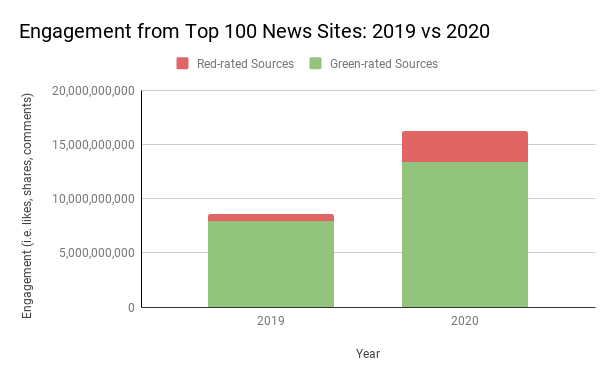Special Report: 2020 Engagement Analysis
Unreliable news sites more than doubled their share of social media engagement in 2020
In a year when misinformation was unavoidable, unreliable websites significantly increased their share of engagement among the top performing news sources on social media, a NewsGuard analysis has found.
Using data from the social media intelligence company NewsWhip, NewsGuard found that engagement — meaning likes, shares, or comments on Facebook and Twitter — from the top 100 U.S. news sources on social media nearly doubled from the first eleven months of 2019 compared to the same period in 2020, growing from about 8.6 billion to 16.3 billion reactions.
These findings build on a recent report from the German Marshall Fund that concluded, using NewsGuard’s data, that engagement with misinformation outlets was higher on Facebook in the lead-up to the 2020 election than in the lead-up to the 2016 election.
The dramatic increase in online engagement in 2020 is not surprising, as the COVID-19 pandemic and the elections have contributed to overall increased use of social media and the internet, with people going online in search of news — and a connection during a period of social isolation.
However, NewsGuard has found that a significant portion of that growth benefitted unreliable websites who fail to meet basic standards of credibility and/or transparency. In 2020, 17 percent of engagement among the top 100 news sources came from Red-rated (generally unreliable) sites, compared to approximately 8 percent in 2019. The graph below shows the growth of engagement, and the increased share from Red-rated sites.

In 2019, sites rated Red by NewsGuard accrued about 700 million interactions. In 2020, 2.8 billion interactions — more than four times as many — came from Red-rated sites. As the chart below shows, that amounts to a 305% increase in engagement for Red-rated sites. Green-rated sites saw a 69% increase.
NewsGuard found that the top Red-rated site, The Daily Wire, saw 2.5 times as many interactions in 2020 as 2019.
The exact engagement by site category is below:
